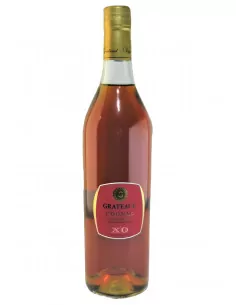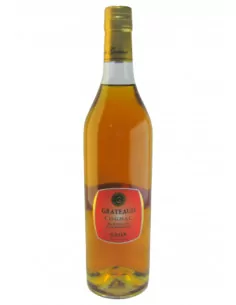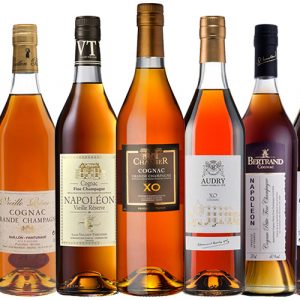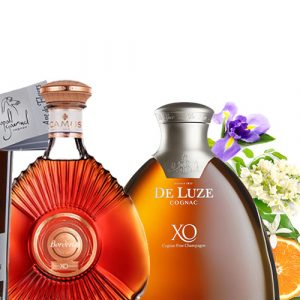Grateaud Cognac
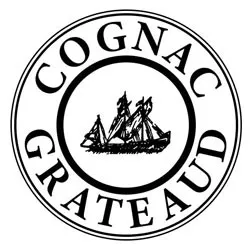
Domaine Grateaud captivates the essence of the Borderies Cru. This small, family-operated domaine stands out for its commitment to traditional Cognac making, producing a range of Cognacs that are as authentic as they are exquisite. With offerings that include Cognacs aged up to 50 years, Domaine Grateaud is a treasure trove, complexity, and the vibrant spirit of the Grateaud family.
Products
Active filters
Price
-
$ 39 - $ 139
Cognac age
Bottle size
ABV
Showing 1-7 of 7 item(s)
Price
-
$ 39 - $ 139
Cognac age
Bottle size
ABV
Showing 1- of item(s)
There are no products.

Taylor and Malte together with David Grateaud
A discovery from the heart of Borderies
Meet 3 generations of winemakers
One of our core missions is to highlight the diversity of Cognac. We do our very best to regularly showcase new and interesting small Cognac producers doing great work from within all of the Crus of Cognac. Our soft spot for the Bons Bois is well documented, as that is where Poullignac is situated and where Cognac Expert got up and running as a blog showcasing a handful of small producers in that southern corner of the Charente. But we have a profound love of all Cognac Crus. So when we recently discovered Domaine Grateaud in the Borderies - Cognac’s smallest most confidential cru - we knew instantly it was exactly the type of producer that needed to be shared with our dear customers.
Introducing Domaine Grateaud, a small intensely family-focused producer of Borderies Cognac located near Chérac, in the named place called La Maine Garnier. New discoveries from the Borderies are rare, which makes this all the more exciting. And the Cognacs are stunning!

From left to right: Jean Pierre (David's father), Maurice (Grandfather), David's brothers

From left to right: Jean Pierre (David's father), Julien (David's brother), Léo (David's son), David Grateaud
The estate owns 41 hectares of vines located within a 3-kilometer radius of the estate property, all on a prime terroir of the Borderies plateau. Since this year, they have been renting a further 16 hectares of vines, also located in the Borderies commune of Chérac. It's interesting to note that renting a plot of vines is not an uncommon route for a small producer. It involves far fewer legal, financial and administrative hassles. This increase in surface area is not innocent, as David's son Léo will be finishing his viticultural studies very soon and will be able to set up on these new plots of vines. The Grateaud family does all the work on these new vines as they do for their own. These leases generally last three years and can of course be renewed.
Six years ago, the Grateaud Vignoble bought a dozen hectares in the Petite Champagnes cru in the commune of Rouffiac. The wines from this other terroir will be bottled as soon as they have acquired the desired age. For now, we wait. Eight hectares of the estate are devoted to Pineau des Charentes and the rest to Cognac. Lastly, as is often the case in the region, they also have a cereal activity for wheat, corn, and sunflowers on plots of land roughly 20 kilometers away from the domaine.





As an interesting anecdote, the Grateaud family has been recognized for their agricultural prowess for decades now. Back in 1932 the French Agriculture Minister awarded David Grateaud’s great grandfather, Alphonse Grateaud, a special recognition Chevalier du Mérite Agricole (in English: Knight of Agricultural Merit) for his outstanding contributions and practices in agriculture.
This special recognition was created in 1883 and at the time was only second in importance to the French Legion of Honour. Impressive! The original document in the image shows this special award.
With regards to the terroir, their hectares are on prime Borderies plateau terroir, with silex everywhere in addition to some clay. We actually have not seen this before in our previous visits throughout the region. The sharp chiseled silex stones were scattered all over the plot of vines. Everywhere we put our feet, we were standing on these silex stones. David says that this strip of land from Chérac to Saint Andre de Cognac has this heavy silex soil, and it makes for typical and the best Borderies Cognac.
Moreover, it has the added benefit that it does not suffer from hydric stress that other terroirs might face in the region. So even in a dry and hot year like 2023, they can see massive yields. He goes on to say that much of the Camus vines in the Borderies are on this band of prime Borderies land.
Among the vines in the Borderies, they still have some very old vines - some dating back 100 years and others dating back to 1951. Vines of this age certainly do not produce many grapes, but the quality can be spectacular.
For the vines in Rouffiac, in the Petite Champagne, things are completely different. David says this is classic Champagne terroir, with a heavy amount of limestone. The land tends to dry out much more easily, and the fact that the vines are lower in altitude makes them particularly prone to spring frosts. But, the quality that can come out of these plots of vines can really be beautiful, David says.
In terms of vineyard risks, they go through the same issues any other producer does in the region: hail, frost, and heat and dryness. There are occasionally problems with certain deer that in the spring get a little too hungry in the vines, but it is not a huge problem. In 2018 they suffered a terrible bout of hail which made them tap into their existing stored climatic reserve. And in very abundant years like 2023, they are able to replenish this stock of climatic reserves to anticipate any climatic problems that may arise in the future.





Harvest & Winemaking
Harvest takes about three weeks to complete for all the domaine’s vines. On the particular topic of harvesting, pressing, and fermenting, the Grateauds are very precise to point a few things out. The freshly harvested grapes are transferred back to the domaine in covered trailers to protect them from any direct contact with the sun or rain. They are especially vigilant that when a batch of grapes arrives at the press, it must be loaded and pressed immediately. They'll even slow down the harvesting speed to make sure there's never a load of grapes waiting to be pressed. David Grateaud says:
Qualitatively speaking, it's a huge plus for us.
Their two new pneumatic presses ensure a fairly smooth operation. Each pass through the press takes around two hours and yields 110-120 hectolitres of grape juice. The freshly pressed grape juice spends half an hour in a settling tank to allow the heavier particles to settle before being transferred to the stainless steel fermentation tanks. Again, what may seem like a benign fact is something very closely monitored: the temperature with which the juice enters the fermentation tanks and the temperature with which the juice actually ferments. The grape juice is brought up to 18° before moving on to fermentation, where it ferments at 24° more or less. All this is controlled by a radiator (flag) inside the fermentation tank. The large stainless steel fermentation tanks are cleaned, as there is always a thick layer of tartaric acid that needs to be removed. Steam cleaning does the job perfectly. And to think that the estate has 20 of these massive, high-precision stainless steel fermentation tanks.
We’ve heard all of these things before, but the Grateaud’s really took their time to emphasize these points to show that there is so much that goes on before the wine even reaches the alambic. Too often we only talk about what goes on during distillation and aging in the cellar. But we must not forget that the underlying quality of the wine determines the underlying quality of the spirit. This is something David Grateaud, his father and son speak of with great conviction.


Alambics
The property owns two alambics, both of 25 hectoliter capacity. The first one dates back to 1972 and the second is a much more recent addition, dating back to 2020. Before the addition of the second alambic in 2020, they did all their distilling with the one still from 1972. Curiously enough, even though both alambics are more or less the same form and function the same way, they give different results with the eau-de-vie. We even smelled it with our own noses as we were on site for our visit during distillation. We were able to smell two different bonne chauffes, but both coming from the same batch of wine. One was from the new still and the other from the older still. Funnily enough, the eau-de-vie from the older alambic seemed to have a more enhanced aromatic profile. We can only speak of aromas here as we did not taste the actual bonne chauffe. Interesting to say the least!
During distillation season, the alambics will run non stop, with the exception of a few pauses for cleaning. Domaine Grateaud distills for Hennessy, Martell, and Courvoisier. For Hennessy and Courvoisier, they will distill the lees, but for Martell they distill only the clear wines with no lees at all. For the production of Grateaud Cognac - not destined for the big houses - they always distill with the lees, because for them, the eau-de-vie produced is much more aromatic, more interesting, richer. Even though they have contracts with the big houses for Compte 00 and Compte 2 Cognacs, their contracts are relatively small which allows them to keep a good stock for their own Cognac and Pineau production.


In the Chai
The chai is a beautiful sight to see with barrels neatly stacked from the ground up to the chai’s ceiling. As we did some tasting directly from the barrel, David’s son climbed up to the top jumping from one barrel up to the next and so on until he reached the exact barrel we were to taste - at ceiling level basically. In the cellar Grateaud prefers 400L barrels from three tonnelleries: Doreau, Loureiro, and Taransaud. It is obvious in speaking with them that they hold a soft spot for the quality of the Taransaud barrels; these barrels produce exceptional results but usually with an exceptional price tag too. David even mentioned that they have done numerous blind tastings and the Taransaud oak always is recognizable amongst the others.
As they stock some eau-de-vie for the big houses, they must respect the wishes of each house, that is:
- Hennessy: strong chauffe, wide grain oak
- Martell: medium chauffe, fine grain oak
- Grateaud’s own production: light chauffe, wide grain oak
After distillation, the eau-de-vie is put into a new oak barrel at its natural alcoholic degree and left for roughly one year. After that first contact with the young oak, it is then transferred to 10-15 year old oak barrels, where it will spend the rest of its aging period. With regards to reducing the alcohol level, they will only start reducing two years before they plan to bottle that coupe (blend basically). Reductions are done in small increments, never exceeding 5% at a time. And the reductions take place slowly over that period of two years leading up to bottling. Each reduction is followed by a period of rest to let the Cognac settle and harmonize. Obviously, depending on which Cognac is to be bottled and its respective age, the amount of water for the reduction will vary.
For example, we tasted a 2011 that only just started to be reduced as it will be incorporated into the Napoleon Cognac in two year’s time. It might require three or four 5% reductions to reach 40%. The XO, on the other hand, is a 30 year old Cognac, so by the time they start doing the reduction, it may only need one or two small reductions before reaching 43% (desired bottling strength for that Cognac).
This was an interesting approach and shows a nice contrast from producers who immediately reduce down to 60% or 55% right after distillation. Lastly, it goes without saying that for the big houses that purchase Compte 2 Cognac, they buy it at its natural alcohol level.




Here’s a short list of some of the things we tasted while in the chai:
- 2023 from an older oak barrel
- 2023 from a heavy toasted Taransaud oak barrel (wide grain)
- 2018 that will become part of the VSOP in two year’s time (reduction starting)
- 2011 that will become part of the Napoleon in two year’s time (reduction starting)
- XO (30 year) at 44% just before its final reduction down to 43% for bottling
- 50 Year old Brut de Fut, 50%, zero reduction whatsoever
- 1978 Pineau de Charentes, from barrel
Interestingly, David released his very first Brut de Fut Cognac in 2014, making him arguably one of the first in the region to bottle a Cognac at natural cask strength. In 2014, this novelty of bottling this Cognac right out of the cask (without any reduction) wasn't practiced at all, so we can think of David as something of a pioneer in this regard.
Lastly, it’s worth stressing that everything is done on site from A to Z by the Grateaud family. When it is raining outside, or otherwise too hot to work in the vines, they are inside doing bottling. Conversely, when the weather permits, they are out in the vines tending to their prime hectares of Borderies and Petite Champagne land.
The Cognacs
All Cognacs are natural in color and with no added sugar, or other additives.
Grateaud Hors d'Age Cognac
40 Years Old

Grateaud Hors d'Age Cognac
40 Years Old
$ 109
excl.
TAX
excl. shipping
Cognac age: Hors d'Age Cognac - 40 Years Old
Growth Area: Borderies
ABV: 43%
Additives: No color, no sugar, no other additives
Bottle size: 70 cl
The Grateaud Hors d'Age Borderies Cognac, a majestic 40-year-old expression, represents the Grateaud family's distilling expertise, capturing the essence of generations of Cognac-making tradition from the heart of the Borderies region. This Hors d'Age Cognac, patiently aged for four decades, showcases an unparalleled depth and complexity, a testament to the art of fine cognac production.
Nose
The bouquet opens with very melted aromas, a unique fusion of warmth and complexity that envelops the senses. Spices and a hint of pepper provide a lively introduction, followed by a rich nutty essence. The fragrance of caramelized pears and apples adds a deep, naturally sweet character, showcasing the spirit's richness. Despite its 40-year age, there's a surprising freshness that speaks to its well-preserved character. It evolves nicely in the glass, so do not rush this one.
Palate
On the palate, the experience is equally rich and multifaceted. The nutty flavors blend seamlessly with the sweet, caramelized notes of pears and apples, creating a harmonious taste. The spices and pepper reemerge, adding layers of complexity and depth. The natural sweetness underscores the richness of the spirit, while its age lends a sophistication that's rare, yet it retains a lively freshness that belies its years. One knows the Cognac has an advanced age, but it still is lively and fresh. 43% abv is spot on too.
Finish
The finish is medium-long, with the spices and sweet caramelized fruit lingering on the palate. There's a continuity of the nutty and naturally sweet flavors, ensuring a rich and satisfying end.
Grateaud XO Cognac
30 Years Old

Grateaud XO Cognac
30 Years Old
$ 90
excl.
TAX
excl. shipping
Cognac age: XO Cognac - 30 Years Old
Growth Area: Borderies
ABV: 43%
Additives: No color, no sugar, no other additives
Bottle size: 70 cl
The Grateaud XO Borderies Cognac, a remarkable 30-year-old gem from the heart of the Borderies region, stands as a testament to the art of Cognac making. Distilled with meticulous care and aged extensively in oak barrels, this cognac unfolds layers of floral and creamy nuances, enriched by the passage of time. Bottled at 43% ABV, it delivers a balanced and profound tasting experience that captivates from the first sip.
Nose
The nose presents scents of maturity, intertwined with the sharpness of pepper and the warmth of spices, suggesting a Cognac with good depth. A captivating aroma of pear cinnamon compote emerges, blending ripe fruitiness with the hint of spice, indicating a well-rounded complexity. The natural sweetness is evident on the nose alone, enriched by the lush, floral notes of miel de fleurs, adding to the richness and fullness of the aroma.
Palate
On the palate, this spirit showcases a good sense of balance and complexity. The warmth of spices and the subtle kick of pepper provide a spicy undercurrent, while the smooth, good natural sweetness and the rich flavor of miel de fleurs create a luxurious mouthfeel. It wears its 43% alcohol nicely. The pear cinnamon compote note persists, offering a delightful blend of fruit and spice.
Finish
The finish is medium but satisfying, with a lingering warmth from the spices and a velvety richness that coats the palate. The natural sweetness and floral nuances of miel de fleurs gently fade. This spirit’s sense of balance and complexity is evident in every sip, making it a truly rich and rewarding experience.
Grateaud Brut de Fût N°35
35 Years Old

Grateaud Brut de Fût N°35
35 Years Old
Cognac age: 35 Years Old Brute Fût
Growth Area: Borderies
ABV: 57.9% - Cask Strength
Additives: No color, no sugar, no other additives
Bottle size: 50 cl
The Grateaud Brut de Fût N°35 Cognac stands as an innovation and dedication of the Grateaud family. This exquisite 35-year-old cognac, hailing from the prestigious Borderies growth area, encapsulates the essence of artisanal craftsmanship and the rich heritage of Cognac production that has been passed down through generations of the Grateaud lineage. Distinctively bottled at natural cask strength, 57.9% ABV, it offers an unadulterated expression of its origin, reflecting a bold commitment to authenticity and quality.
Nose
The aroma showcases an alliance between fruit and floral notes, with the succulence of peaches leading the way. There's a refreshing twist of eucalyptus and menthol, which adds a bright, invigorating layer - powerful and warmly cooling. Underneath, the darker, richer scents of honeys and muscat grapes weave in, complemented by the sweet, concentrated aroma of dried raisins in syrup. A sprinkle of cinnamon enhances the complexity, while the fresh scents of ripe apples and pears round out the bouquet. A subtle hint of tobacco adds depth, introducing an earthy, rich dimension.
Palate
On the palate, this spirit is a delightful mix of flavors. The sweet juiciness of peaches and Muscat grapes is beautifully balanced with the orchard fruit notes. The warmth of cinnamon and the unique taste of tobacco contribute to the complexity. The darker, richer honeys meld with the syrupy sweetness of the dried raisins, creating a lush, full-bodied experience. Present tannins add structure, giving the spirit a slightly robust edge, while the cooling sensations of eucalyptus and menthol provide a refreshing counterbalance.
Finish
The finish introduces a slight bitter note, an intriguing contrast to the sweetness and richness that precede it. This bitterness, coupled with the lingering flavors of fruit, floral, and the refreshing menthol, creates a complex and memorable end.
Grateaud Pineau des Charentes
From 1978 - Cask N°77

Grateaud Pineau des Charentes
From 1978 - Cask N°77
$ 62
excl.
TAX
excl. shipping
Pineau age: from 1978 - Cask N°77
Growth Area: Borderies
ABV: 18% - Cask Strength
Additives: No color, no sugar, no other additives
Bottle size: 50 cl
The Grateaud Très Très Vieux Pineau des Charentes, from 1978 and drawn from Cask N°77, embodies the essence of the Charentes terroir. Crafted from a meticulous blend of white grape juice and very young, high-alcohol content cognac, this Pineau des Charentes shows the Grateaud family's dedication to excellence. Aged in Limousin oak casks, it develops an unparalleled complexity and depth of flavor, further enriched by its storied origins in Cask N°77, ensuring a truly unique and memorable experience.
Nose
The aroma unfolds with a delightful bouquet of honey, prunes, and candied orange, inviting a rich and indulgent first impression.
Palate
Fruity and rich, the taste is a luxurious blend of hazelnut butter and dried fruits, with a subtle hint of gingerbread. The vanilla notes from Limousin oak barrels envelop the palate, creating a rounded and supple experience. A distinctive pineau rancio character adds depth and complexity.
Finish
The finish is warm and lasting, leaving a memorable impression of the unique blend of flavors that defines this exquisite Pineau des Charentes.

Conclusion
It just doesn’t get any better than this! Domaine Grateuad is a strongly family-based producer making Cognacs that ooze authenticity, quality, and craftsmanship. The range of Cognacs spans an interesting range of ages, even dipping into old Cognac territory with the beautifully complex 40 year old Hors d’Age, the robust 50 year old Brut de Fut, and the spectacular 1978 Pineau des Charentes. And the Napoleon is as fine a Napoleon Cognac we’ve ever come across: it’s a lovely representation of the Borderies cru, it's easy to drink, and serves equally well as an aperitif or digestif. This XO is a Cognac with many of the mature Borderies markers.
David Grateaud, his son and his father are extremely generous people eager to share everything and anything about how they make Cognac. They are just down to earth very real people, who are very skilled at their craft of making Cognac. And what a treat that this find comes from the Borderies, a small confidential Cru that we do not see enough of these days.
We cannot thank them enough for their time and attention, and we could not be more pleased to share this gem with you, our dear customers. Grab a few bottles, you will not regret it. We promise!


See some blog posts related to Grateaud Cognac
The 12 Best Cognacs Under $100: Eaux-de-vie at Great Age and Quality
When you think of fine Cognac, perhaps you imagine King Louis XV sipping it from his gilded cup, the taste of complex flavors from rich oak and toasted vanilla beans to wintry spices delighting his...
All About Floral Cognacs (+ 12 great examples)
Floral is a term that’s often used when describing the aroma and taste of a Cognac. Such technicalities can be difficult to understand—especially if you’re at the beginning of your Cognac tasting...
Let the Angels Take Their Share
On the face of it, Cognac as a spirit is actually quite simple. A producer grows grapes (mainly ugni blanc), makes a white wine, distills it twice, stores the distillate in new or used oak barrels,...





